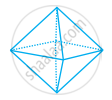Advertisements
Advertisements
प्रश्न
Can a polyhedron have V = F = 9 and E = 16? If yes, draw its figure.
उत्तर
Given, Vertices = 9, Face = 9 and Edges = 16
Using Euler's formula for polyhedron,
F + V – E = 2 ...[Where, F = faces, V = vertices and E = edges]
⇒ 9 + 9 – 16 = 2
⇒ 18 – 16 = 2
⇒ 2 = 2
Hence, the given values satisfies the Euler's formula.
So, a polyhedron can have V = F = 9 and E = 16.
Thus, we can draw a octagonal pyramid.
APPEARS IN
संबंधित प्रश्न
Verify Euler’s formula for the following three-dimensional figures:

Which of the following cannot be true for a polyhedron?
Euler’s formula is true for all three-dimensional shapes.
Look at the shapes given below and state which of these are polyhedra using Euler’s formula.

Look at the shapes given below and state which of these are polyhedra using Euler’s formula.

Look at the shapes given below and state which of these are polyhedra using Euler’s formula.

Using Euler’s formula, find the value of unknown y in the following table.
| Faces | y |
| Vertices | 12 |
| Edges | 18 |
Using Euler’s formula, find the value of unknown p in the following table.
| Faces | p |
| Vertices | 6 |
| Edges | 12 |
Check whether a polyhedron can have V = 12, E = 6 and F = 8.
A solid has forty faces and sixty edges. Find the number of vertices of the solid.
